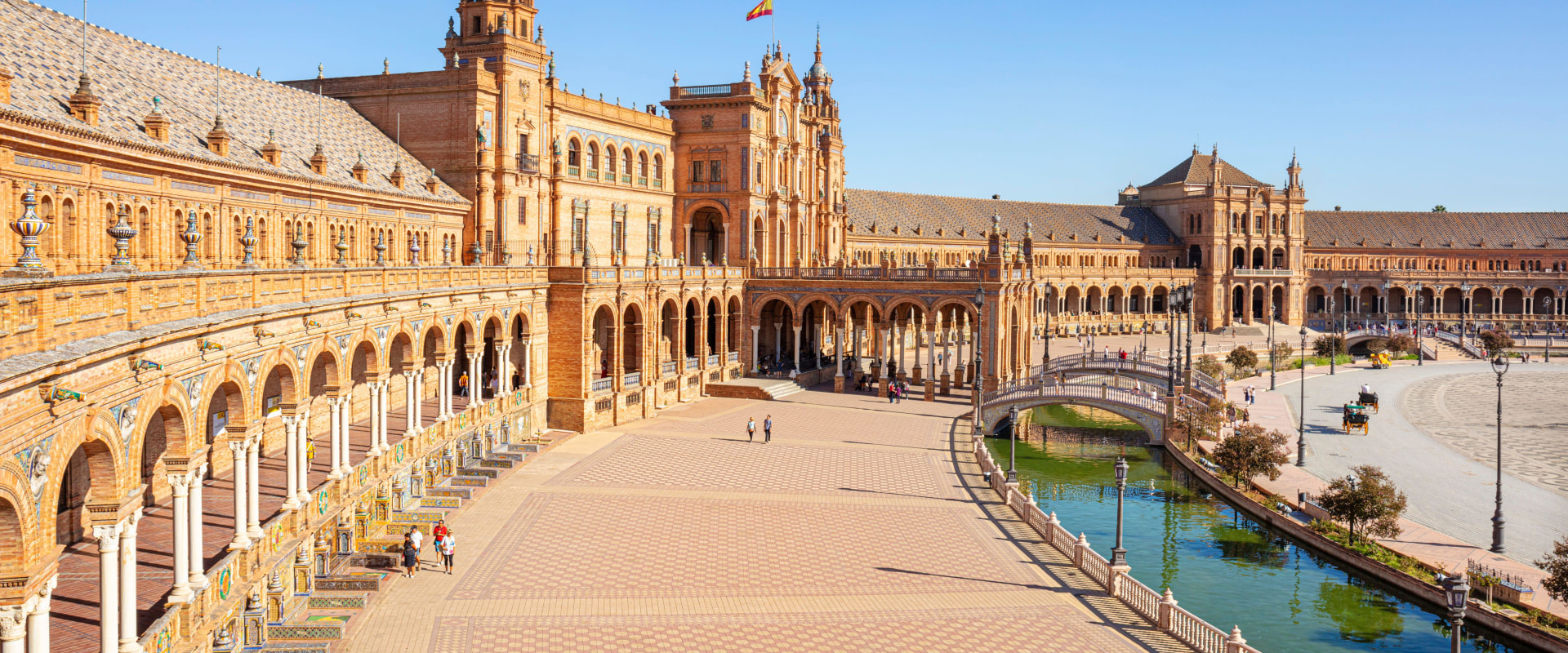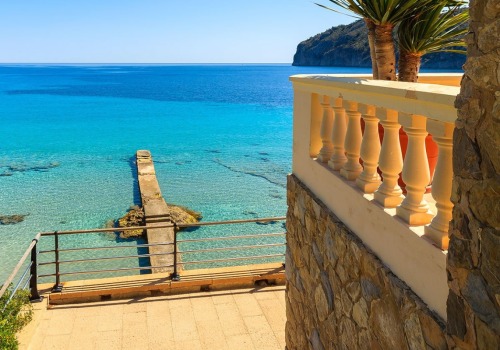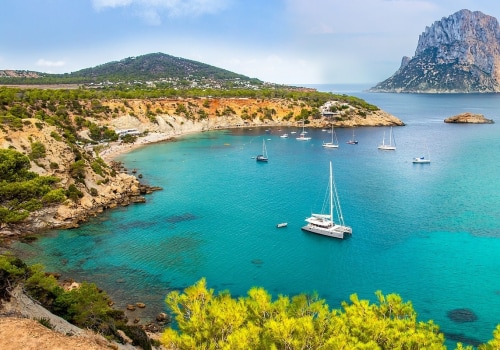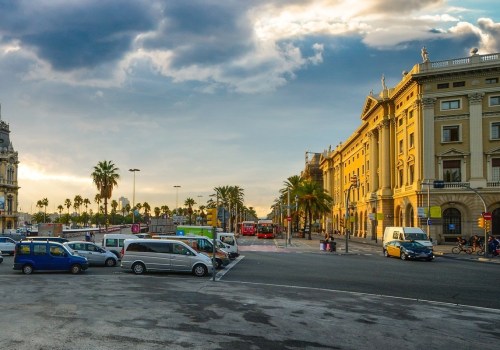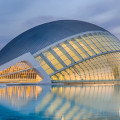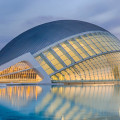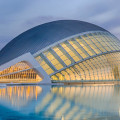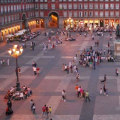The Running of the Bulls · 8.Pamplona is a city in Navarra, famous for its San Fermín festival that is held every year from 6 to 14 July. At the heart of the festival is El Encierro, el encierro, an activity that consists of running in front of a dozen bulls that have been released, on a tour of the streets of the city. Protected from strong winds by steep cliffs and islands, many say that La Concha, in San Sebastián, is one of the best urban beaches in Europe, let alone in Spain. Here you can surf, stroll along the promenade in search of good restaurants and enjoy the beautiful views of the beach.
The Aqueduct of Segovia is one of the best preserved monuments left by the Romans in Spain. The old aqueduct carries water 16 km (10 miles) from the Frio River to Segovia and was built with about 24,000 solid granite blocks without the use of mortar. Probably built around 50 AD, it still provided water to the city in the 20th century. Located between Madrid and Valencia, Cuenca is a wonderful example of a medieval city, built on the steep slopes of a mountain.
The numerous “hanging houses” are built to the edge of the cliff, making Cuenca one of the most striking cities in Spain, a jewel in the province of Castilla La Mancha. Ibiza is one of the Balearic Islands in the Mediterranean Sea, off the coast of Spain. The island is one of the most popular party destinations in all of Europe. During the summer, the island's population doubles as tourists flock to Ibiza to enjoy nightclubs, beach bars and restaurants.
Located in the foothills of the Sierra de Guadarrama, El Escorial was the political center of the Spanish empire under King Philip II. Philip named Juan Bautista de Toledo an architect in 1559 and together they designed El Escorial as a monument to the role of Spain as the center of the Christian world. Nowadays it works as a monastery, royal palace, museum and school. Part fortress, part palace and part garden, the Alhambra is situated on a plateau overlooking the city of Granada, in southern Spain.
The palace was built in the 14th century by the Nasrid sultans. The Alhambra is now one of the main tourist attractions in Spain and many visitors come to Granada just to see the Alhambra. There is much more besides. And that's not to mention the beaches of the famous Costas.
Or the incredible Roman ruins that dot the country, especially Segovia, with its aqueduct. Expect history, good food and lots of sunshine, all in healthy doses. Plan your trip to this incredible Mediterranean travel destination with our list of the best places to visit in Spain. Founded in 25 AD by the Romans, Mérida has some of the most impressive, extensive and best-preserved ruins in all of Spain.
Nowadays the capital of the autonomous community of Extremadura, the city is located in the central-western part of the Iberian Peninsula, with the Guadiana and Albarregas rivers that cross it. Bilbao, the largest city in the Basque Country of Spain, is located on an estuary just 16 kilometers south of the Bay of Biscay. As its climate is milder and more humid than the rest of the country, the city's parks and riverbanks are fertile and green, as are the rolling hills that surround it. Bilbao was better known as an important seaport and industrial city in northern Spain until the construction of an architectural marvel in the 1990s known as the Guggenheim Museum.
Since then, this capital city of Biscay has experienced a tourist boom, promoting economic growth and the revitalization of its many hidden gems, making it a popular destination. Other places to visit in Bilbao include the 14th-century Gothic Cathedral of Santiago and the Basilica of Begoña. Built in 1909 and recently renovated, the Alhóndiga is a multipurpose complex that houses a library, restaurants and a glass-floored rooftop pool. Salamanca, the capital and largest city of the province of the same name, is located on the banks of the Tormes River, on the northern plateau of Spain.
Widely regarded as one of the most beautiful Renaissance cities in all of Europe, its historic center is full of architectural treasures and incredible monuments that date back centuries. Nearby, you can find other impressive sights to see, such as the New Cathedral and the Old Cathedral, which showcase exquisite architecture. Like the rest of the city, they are built of sandstone. It is these warm tones that give Salamanca its nickname: La Dorada or “Ciudad Dorada”.
Although history is everywhere, Salamanca has a lively and youthful atmosphere thanks to its large student population. Surprisingly, the University of Salamanca was founded in 1218 and is one of the oldest institutions of higher education in Europe. Cuenca, one of the most popular cities to visit in the Spanish region of Castilla La Mancha, is in a precarious position at the point where two deep gorges of the river meet. His strategic environment saw him fight, conquered and ruled by both Muslims and Christians, with Napoleon himself leaving his mark at the beginning of the 19th century.
The charming city is particularly known for its hanging houses, or hanging houses, which are built on the side of the cliff on which Cuenca stands. In addition to being phenomenal feats of engineering, these amazing buildings make fantastic photos and are best seen from the San Pablo Bridge. Ibiza, the third largest island in the Balearic Islands, is located off the east coast of Spain, surrounded by the crystal clear waters of the Mediterranean. While famous for its vibrant nightlife and summer club scene that attract world-renowned DJs to its shores, the island has many other different faces.
Quite rocky and rugged, Ibiza is lined with beautiful bays and beaches; this, together with its warm, sunny and dry climate, makes it an excellent beach holiday destination. The largest city on the island, Ibiza Town, has a majestic old town walled on top of a hill overlooking the sea. While it is true that you can find relaxing rural retreats and quiet coastal towns on the island, many people visit Ibiza for its incredible party scene and exciting electronic dance sets. In summer, its hectic clubs stay open during the night until dawn, when the sun finally rises over the sea.
Segovia, the capital and largest city of the province of the same name, is located in a picturesque place with the mountains of the Sierra de Guadarrama rising in the distance. Its sun-drenched streets stretch on both sides of the Eresma River in the inland plateau of Spain, with Valladolid and Madrid not far away. Segovia is famous for its historic sights. Within its walled old town is the Aqueduct of Segovia, which was built around 100 AD by the Romans.
While this engineering marvel acts as the symbol of the city, other amazing sights can be found in the immediate vicinity, such as a magnificent Gothic cathedral and numerous churches, convents and monasteries. The other main attraction is the elegant Alcázar de Segovia, located on top of a rocky outcrop overlooking the city. Said to have inspired Walt Disney's Sleeping Beauty Castle, the medieval castle and palace boast a wealth of elegant architecture and were once one of the favorite royal residences of the Kings of Castile. Located in one of the most spectacular scenarios imaginable, Ronda, in southern Spain, stretches on both sides of the rugged El Tajo gorge, overlooking the valleys and hills that lie in front of it.
Due to its rich cultural heritage and history, as well as its spectacular clifftop location, Ronda has attracted writers and poets alike to its ancient streets. While Ernest Hemingway, James Joyce and Rainer Maria Rilke visited at one time or another, Ronda now attracts many tourists and is one of the most popular and picturesque towns to visit in Andalusia. Perched on top of a mountain in central Spain, Toledo was the Spanish capital until the 16th century. Because it was inhabited by Jews, Christians and Muslims for many centuries, the city is sometimes called the “City of Three Cultures”.
Today, Toledo is a popular destination for its wealth of historical art and architecture that dates back to the Roman Empire. Testimony to the busy history of the city are its most notable monuments, the 16th century Granada Cathedral, with its magnificent vaulted ceiling, and the famous Alhambra, a large Moorish palace with luxurious gardens and Arab baths. The gardens of the Alhambra and the Generalife, Granada The Great Mosque of Cordoba (Mosque) Construction materials of Roman and Visigoth buildings were used in the construction, which began in 785, and by 1000 had grown to its current dimensions, its prayer hall with no less than nineteen corridors. No matter where you are or in which direction you look, its rows of columns and rounded Moorish arches line up in symmetrical patterns.
San Lorenzo de El Escorial, about 45 kilometers northwest of Madrid, was the summer home of the kings of Spain, and in 1563, work began here on a huge complex, which would include a monastery, a church, a royal palace, a mausoleum, a library and a museum, all conceived as a monument to Philip II and his reign. The result is an impressive collection of attractions, built around 16 courtyards, their rooms and structures connected by 16 kilometers of corridors. At its core is the church, whose highlight is the 30-meter-high altarpiece of Herrera, made of jasper and red marble and accessed by a stretch of 17 steps. La Giralda tower, Seville Cathedral and Alcázar combine to form a UNESCO World Heritage Site.
The tower is a minaret, a masterpiece of Almohad architecture, according to UNESCO. The cathedral has more interior space than St. Peter in Rome and a 37-meter high altar of carved statues completely covered with gold. The opposite Alcazar was started by the Moors in 712 and continued after the Christian reconquest by King Pedro in the 1300s in the ornate neo-Moorish style called Mudejar.
The rooms and lounges are stunning, and the gardens are a pleasure to stroll, shaded by fragrant orange and lemon trees. To the east is Santa Cruz, the old Jewish Quarter, a neighborhood of whitewashed houses, iron balconies and courtyards full of flowers. One of the most outstanding monuments of early Romanesque architecture, the cathedral was built between 1060 and 1211, and despite the Baroque transformation of the exterior in the 16th to 18th centuries, the interior remains in the purest early Romanesque style. You'll see these two periods at play as you enter the western front, through one of the most impressive church facades in Spain.
Enter to look towards the Portico de la Gloria, part of the old west front now hidden by the 18th century façade. This triple door is one of the largest and most magnificent collections of Romanesque sculpture in the world. The heartbeat of Spain's vibrant capital, Plaza Mayor, has played an important role in Madrid's life since the 16th century, when Philip II entrusted the task of designing it to his favorite architect Juan de Herrera, builder of El Escorial. Built for the Ibero-American Exhibition of 1929 to celebrate the regions of Spain, the Plaza de España is an impressive semicircular pavilion surrounded by colonnades.
Beautiful panels of colored tiles representing each of the provinces of Spain overlook the long swimming pool, which is crossed by bridges. It's a popular spot for strolling or paddling on a rental boat around the pool and under bridges. The largest and most lively beach is Playa Inglés in Maspalomas, which abounds with cafes, restaurants, shops, playgrounds and other attractions. At one end is one of the natural wonders of the archipelago, a vast protected area of gigantic sand dunes.
These reach a height of up to 12 meters and change constantly as they are shaped by the wind and the sea. To complete the illusion of the desert, you can ride a camel through this desolate and unearthly landscape. You can explore El Teide in several ways. You can drive or walk inside the caldera, the crater floor, 12 miles in diameter and an arid lunar landscape of colorful rock formations that is like driving towards the center of the earth.
You can climb the Teide cone, but an easier way to get close to the top is by taking an eight-minute cable car ride. On a clear day, the views cover the entire archipelago and can extend to North Africa, the closest land mass to the Canary Islands. The most spectacular is Arcos de la Frontera, whose square next to the Gothic church ends vertiginously on a 137-meter cliff, which overlooks a valley of olive, orange and almond trees. Its labyrinth of winding cobblestone streets lead to cafes and craft shops selling pottery and ceramics to a Moorish castle.
A total of 19 of these villages with small white houses are located in the vicinity of the Grazalema Nature Reserve. Grazalema and Zahara de la Sierra are two others worth seeing. A good starting point in the region is Jerez de la Frontera, home of flamenco and Andalusian thoroughbreds. See the precision ballet of these horses at the Royal Andalusian School of Equestrian Art and, to enjoy authentic flamenco, visit the Flamenco Cultural Center.
One of the best holiday spots in Spain for couples is the tourist island of Ibiza. It's a short flight or ferry ride of five to six hours and it's about 100 miles off the Spanish coast. Ibiza is the largest of the Balearic Islands, a group of mainly tourist islands in the Mediterranean Sea. The other three larger islands, Mallorca, Menorca and Formentera, are also popular places to see in Spain.
Popular sites and attractions in Toledo include the Alcázar, the Great Defence Wall, the El Greco Museum, the Monastery of Santa Domingo, the San Martín Bridge with its two towers and the 15th century Monastery of San Juan de Los Reyes. Fantastic clean beaches, pine-covered landscapes, picturesque fishing villages and tranquil surroundings are some of the many attractions that attract visitors to this picturesque part of Spain. From the Pyrenees to the Mediterranean, and from there to the Atlantic, Spain is more diverse than stereotypes lead you to believe. Exceptional tourist attractions, lively festivals and lively nightlife make Seville the top destination in southern Spain.
The best thing about this cultural attraction is that it can be seen all year round and practically anywhere. The main attractions include the cathedral of Huesca, the Romanesque monastery of the abbey of San Pedro el Viejo and the ruins of the castle of Montearagon from the 11th century. Ibiza offers some of the best nightclub experiences in the world, attracting some of the best DJs and artists on the nightclub circuit. When you're hungry, head to the city's Central Market, a huge Art Nouveau market (built in 191) filled with food vendors and cafes (along with souvenir shops and other tourist-type businesses).
The Balearic Islands are made up of the islands of Mallorca, Menorca, Ibiza and Formentera and are home to some of the most incredible beaches and coves you'll find in Spain. That year almost 60 million foreign tourists were received, according to the World Tourism Organization, which is based in Madrid. This map of tourist attractions in Spain will allow you to easily discover monuments, museums and places to visit of Spain in Europe. The opening in 1997 of the incredible curvy, titanium-clad Guggenheim Museum designed by Frank Gehry really put this ancient industrial port city on the map of world tourism as a must-see spot in Spain.
Here you will find everything that is great about this charming region of Spain, its authentic culture, stunning historical sites, great food and its friendly fun-loving residents. This turns the old city into a kind of open-air museum, illustrating the history of Spain, and has been listed by UNESCO as part of the cultural heritage of humanity. . .
